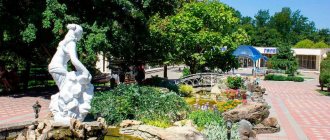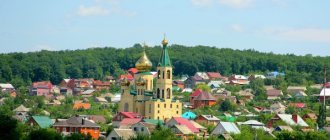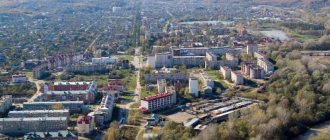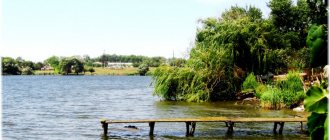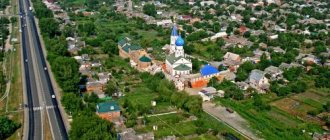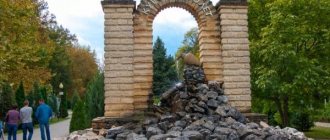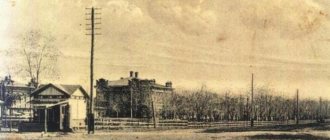Description of the resort city
The city is located on the banks of the Psekups River (a tributary of the Kuban), in a valley between the northern slopes of the Kotkh and Pshaf mountain ranges. It is literally buried in deciduous and mixed forests, greenery, flowers; and a large alley of tall coniferous trees (Alley of a Thousand Pines) leads to the health resorts at the ancient mineral springs. In the foothills there are dozens of large and small, old Soviet and more recently built sanatoriums and hotels, where tourists combine relaxation with health promotion. From these health resorts, excellent hiking routes are laid through the forested mountains - with bridges, ladders and fences in dangerous places.
Hiking along these hiking trails is very beneficial for anyone who suffers from asthma and other respiratory diseases. And any other person will also benefit from the local fresh air, enriched with beneficial phytoncides. The local climate can be described as exceptionally mild. It is transitional from humid subtropical to temperate continental.
At the Goryachiy Klyuch balneological resort, several types of mineral water are used. Thermal (up to +60 C°) sulfide chloride-bicarbonate sodium springs are used for medicinal baths. This treatment is prescribed to patients with diseases of the musculoskeletal system, peripheral nervous system, and female genital area. Mineral waters from sources No. 21, 58, 104 are taken orally. They belong to the hydrocarbonate-chloride-sodium type and are similar to the Essentuki waters, differing from them in the gas fraction. In Essentuki there is carbon dioxide, and in Goryachy Klyuch there is hydrogen sulfide. All these mineral waters are presented in the ancient Drinking Gallery, located on the territory of the sanatorium park. You can drink as much as you like for free, but you have to pay to take water out of the gallery (with the exception of a small 0.5 liter bottle).
Drinking gallery in Healing Park.
On the southwestern outskirts of the city, close to the mountains, sanatoriums, boarding houses and hotels are concentrated. The complex of buildings of the main sanatorium “Goryachiy Klyuch” is a real architectural monument. Most health resorts are adjacent to the Mountain (Healing) Park or are located directly inside it.
This magnificent park has no clear boundaries and in many places simply merges with the wild forest. On the territory of the Healing Park there are Mineralnaya with the Alexander Spring, from which history began, and the beginning of Dante’s Gorge, and the beautiful Iverskaya Chapel, right in the mountain, and the ruins of the ancient fortress Psyfabe, and the Cockerel rock. From the park you can go to the embankment of the Psekups River and walk along the suspension bridge over this river. The outskirts of the city are famous for the presence of numerous caves, waterfalls on mountain rivers, and mysterious ancient dolmens.
Unique natural places
The main attractions of Goryachiy Klyuch are nature and its most beautiful places.
Waterfalls
What you definitely need to see in Goryachy Klyuch are its picturesque waterfalls:
- Hell's Falls. Agree, a sonorous name, and at the same time mysterious. People called it that for its resemblance to the kingdom of the dead. By the standards of waterfalls, it is not high (only 12 m); from sharp, ominous-looking stones, water rapidly falls down into a deep bowl. However, the nature around is so fragrant that the overall picture is not at all frightening, but picturesque. The road to the waterfall is not easy. If you are new to such routes through mountains and forests, then it is better to go with a tour of rocks and waterfalls for the first time.
- You can go to another beautiful waterfall - Ayuksky. It is located 10 km from the Phanagorian village. The flow of water is especially impressive because it flows in two steps.
Among the numerous waterfalls in the vicinity of Goryachiy Klyuch, there are others that you can reach on your own. Each has its own name and an interesting legend - Chepsinsky, Berendey, Sobachkin, Kesukh, Maltsev, Mouth of the Devil, Kaverzinsky, Dolmenny. You just need to set aside a day, stock up on provisions and go on an unforgettable journey. Don’t forget your gadgets, you will take photos at every step, because the places are indescribable.
Rocks
What else you must see in Goryachy Klyuch are the numerous, beautiful rocks with interesting names:
- Mirror. The rock received this unusual name due to its ability to reflect nearby objects. At the top it is steep and smooth, and at the bottom it has a negative steepness. Professional climbers often conduct their training here.
- Temptations. The rock is not high, only 10 m, and many tourists think that they can climb to the top without any problems. But due to the sheer steep slope, not everyone can do this. So the temptation remains to go conquer the rock again.
- Natashkina. Local residents named this rock in honor of a girl from Krasnoyarsk, Natasha, who was vacationing in their area. She constantly praised the nature of her native land, but at the end of the vacation she admitted that some local natural attractions were more beautiful than those in her homeland. She especially liked the high rock (32 m), which after the girl’s departure received the name Natashkina.
- Monastic. These rocks have a very interesting structure; they consist of many grottoes and niches. A long time ago there was a landslide here that covered the ancient monastery, hence the name of the rocks. At their feet there are two mineral springs – ferrous and hydrogen sulfide.
- Cockerel. The high 28-meter rock is visible from afar. It received this name due to the teeth at the very top, which are shaped like a rooster's comb. Inside the rock, two caves were manually cut out of stone - the Staircase of Life and the Sounding Cave. And at the very top there is an observation deck, the views from it are stunning - the entire valley of the Psekups River is in full view.
- Alquins. These rocks reach a height of 18 m. Where did they get their name? Student Aleftina from Rostov, whom her family called Alka, was vacationing in these places with her dad and brother. While walking along the picturesque rocks, the girl got lost. But brave Alka was not taken aback, climbed onto the highest rock, began screaming and waving her red scarf. Her relatives found her, and from then on the rocks called Alkiny.
Alexandrovsky spring
Within the city limits, near the Psekups River, there is a low rocky mountain, which seems to be cut by gorges and caves, and shrouded in fragrant coniferous forest. At its foot there are mineral springs, one of which is Aleksandrovsky - the oldest, the ancestor of the resort. When people realized what miraculous powers the water from the source had, a health resort was built nearby. People with diseases come to be treated with its waters:
- musculoskeletal system;
- digestive organs;
- of cardio-vascular system;
- male and female reproductive functions.
About the history and coat of arms of the city
Before the Caucasian War of the mid-19th century, the Circassian (Adyghe) village of Psyfab (“hot water” in translation) was located on the territory of the city. In the 1860s, in connection with the end of hostilities in the Caucasus, that part of the indigenous population that refused to recognize the power of the Russian Tsar was deported to Turkey. Including residents of the village of Psyfab. In 1864, a balneological resort was founded at local mineral springs by the military department. It included a military hospital, baths and drinking water pump room, and a park.
The village of Goryachiy Klyuch was founded in 1868, but in the 19th century, few people in the Russian Empire knew about this resort. From 1906 to 1920 the settlement was called Alekseevsky Goryachy Klyuch; in 1926 the place was transformed into a village; since 1930 it received the status of a resort village. During the Great Patriotic War, Goryachy Klyuch was occupied by fascist troops for several months. The growing resort village was recognized as a city on November 11, 1965.
Coat of arms of the city of Goryachy Klyuch.
The city's coat of arms symbolizes the favorable natural and climatic conditions of the resort and its mineral springs. On a blue background there is an arch and a tilted amphora pouring out water - all of this is silver. The arch symbolizes the open gate, a symbol of the hospitality of the residents of the resort city. The amphora and the water pouring out of it are a symbol of the source of life and health. In Soviet times, the coat of arms of Goryachiy Klyuch depicted gushing springs, a medical emblem (a bowl and a snake), and a ring with an ear of grain and a gear.
Museum of History and Local Lore
The museum was founded in 1864 and is the oldest in the country. Now it stores exhibits that tell about the history of the city, ethnography, geology, and paleontology. The museum consists of several halls, each of which represents a different period in the history of the city. The first hall is dedicated to ancient times and the Middle Ages. The second hall introduces the period of the city's formation. The third hall will tell about the period of the Great Patriotic War. This period was significant for the city, since it was captured and liberated in January 1943 by the forces of not only Red Army soldiers, but also local residents. And the last fourth hall tells about the modern city of Goryachy Klyuch.
Alexandrovsky spring
Right within the city limits, on the banks of the Psekups, rises the Key Mountain - a small rocky formation, cut by caves and gorges, shrouded in fragrant pine forests. At the foot of this mountain, healing springs gush out from under the centuries-old sandstone. The oldest of these sources is Aleksandrovsky. This is the actual progenitor of the resort, the root cause of the founding of the city.
The oldest source of the resort city.
On June 15, 1864, the grand opening of the hydropathic clinic took place. All sources were consecrated, and the largest of them were named Aleksandrovsky and Mikhailovsky. The oldest source of healing water is located not far from the Goryachiy Klyuch sanatorium. Getting to this place is easy: it is the final stop of any city transport.
Historical sites and museums
City Historical Museum
The decision to create a museum came in 1998, at which time the collection of exhibits began. Two years later the grand opening took place.
Today his collection amounts to 6 thousand items and is housed in three halls:
- “Archaeology”: materials from ancient and medieval times are presented, the history of the region is told.
- “Kuban Life”: the exhibition is dedicated to the Psekupsky mineral waters and their influence on the formation of the settlement.
- “Military History”: the exhibition covers war times, introduces the personality of intelligence officer Alexander Ivanovich Kozlov, a resident of the city, whose story formed the basis of the films “The Path to Saturn” and “The End of Saturn”.
Drinking Gallery
Address: st. Psekupskaya, 2 Opening hours: Mon-Sun 07:00-19:00, break 14:00-15:00
On the territory of the sanatorium in the city center there is a Drinking Gallery. Water is supplied here from three mineral springs.
Water from the 21st spring is useful for patients with gastritis, as it is saturated with hydrogen sulfide. In the other two - 58th and 104th - it is salty and hot (38-45˚С).
It is recommended to drink it here, but if desired, any visitor can take 0.5 liters with them for free.
Psyfabe Fortress
Coordinates: 44.622145, 39.091691 How to get there: to the restaurant “Old Castle” by car or bus to the stop “Sanatorium Goryachiy Klyuch”, then on foot; travel time - 30 minutes.
In the valley of the Psekuls River there were at one time several fortresses, the most famous of which was Psyfabe. This is one of the most ancient buildings in Russia.
The citadel is located on the top of a cliff - the highest point in the area. Once it had a stone fence, observation towers and shelters for people.
Today, only ruins remain of the fortress.
Mountain (Healing) Park
If you reach the end of the fragrant Alley of a Thousand Pines, you can see a sculptural composition with a small fountain, similar to a 3D copy of the city coat of arms - an amphora with healing water and an arch, with an inscription on the pediment informing that the Mountain Park begins next, and the resort already 140 years old. This is not the only arch in the park. One of the calling cards of the city is a more modest in size, but no less beautiful arch with two lions at the foot. It was erected in honor of the 50th anniversary of the resort.
The old entrance to the Mountain (Healing) Park is an arch from 1914, erected for the 50th anniversary of the resort.
The huge park has many picturesque alleys; sculptures and art objects; places where you can have a tasty snack; retail outlets that sell medicinal herbs and herbal infusions, honey, etc. health products. The mountain park was specially laid out in such a way that it organically merges with natural forests. Directly from the alleys of the park you can get to various hiking trails that take travelers to local attractions and, preventing them from getting lost in the forest, return them back to the sanatorium-resort complex. The park also houses a drinking pump room - a gallery of mineral waters.
Where to go with children
entertainment town "Tigger"
Older children, having visited the healing park and learned about its legends and history, will be able to get carried away just as much as you and plunge into the atmosphere of those times.
For everyone who loves active recreation and likes to travel “at their own pace,” Goryachiy Klyuch is one of the most ideal places. Moreover, it is very close to Krasnodar.
You can park near the Old Castle Hotel. And here the rest begins in the shade of the trees, you can take pictures with fountains in the form of a waterfall and a mill. There is a playground for children, and adults can enjoy tasty treats in the cafe if they need refreshment. Next we cross the bridge over the Psekups River and here it is - the park area of the city of Goryachiy Klyuch. And you slowly begin to wander along the shady alleys, where there are many plants and trees, since the park is practically adjacent to the forest, as if merging with it, sit on benches, wander along the paths, listen to the chirping of birds.
In the center of the park there is a Mineral Glade, next to it there are wells of local sources of mineral water, which from here flows into the Drinking Gallery and the Hydrotherapy Center. Drinking gallery: you buy cups at the entrance (ordinary plastic ones, although you can bring your own if they are available). There are taps with warm mineral water and cold, they are also divided into salted and non-salted. You can drink as much as you like - water is free, many people pour it into bottles with them. In general, this is a paradise for photography lovers - there are figures of all kinds of animals, flowers and water cascades and the well-known golden lions.
There is also a historical landmark (for retro lovers) - the Adyghe Pillar. It is made from a fragment of a Byzantine column and is decorated with inscriptions in Arabic carved into the stone. It was installed long ago for the eternal memory of a certain Khapach Lakshuk, one of the most famous heroes of the Bzhedukho tribe.
We return to the river: we see a small chapel built in honor of the Iveron Icon of the Mother of God. It is carved right into the rock - and blends very harmoniously with the surrounding landscape. On Fridays at 11.00, Akafest (church service) is held there.
Nearby is the healing Iveron spring (ferruginous mineral water) - illuminated in the name of the healer Panteleimon. Feel free to drink this water, and drink a lot - there are rumors that by drinking a bucket, you can miraculously rejuvenate.
We recommend wandering around Dante's Gorge - a very beautiful combination of nature and modern “rock painting”. People tried to immortalize in stone their names, love stories, sacred symbols, even not only their own portraits, but also the faces of their leaders. In general, there is something to look at, and if you wish, I think you won’t be able to resist scribbling a message for history.
Through Dante's Gorge or along the river you can climb the Cockerel Rock - this is a sheer cliff of 28 meters. The top of the rock consists of six teeth, reminiscent of a cockscomb. It is visible from the Don highway. From the Rock of Salvation (Cockerel) there is a beautiful view of the valley of the Psekups river. Anyone who wants forest walks can go beyond Cockerel into the forest. In general, you can spend the whole day here!
For those who want new experiences, one of the most easily accessible natural attractions of Goryachiy Klyuch is the Bogatyrsky Caves. Even with small children you can easily reach them. Drive past Goryachiy Klyuch along the M-4 Don highway and turn towards the village of Fanagoriyskaya. You move along the road past the “Charming Polyanka” tourist center. And on the right you will see a small path up the mountain.
You climb up through the forest for about 15 minutes - and here they are, the Bogatyr Caves! Those who have already been to the caves advise taking flashlights. At first you climb on all fours, and then the caves widen and you can easily stand upright. There are no living creatures in the Bogatyrsky caves - you don’t have to be afraid, there aren’t even cobwebs there. There are so many people there, especially during the season, that all the living creatures have long been scared away. The caves are made of sandstone; it absorbs water well, so it is not dirty there. Ordinary pants and sandals with good soles will be enough).
Drinking gallery of three springs
Mineral water is supplied inside the gallery from taps from three different sources. They differ from each other in the taste of mineral water, chemical composition and temperature. The water of one of the healing springs has a pronounced hydrogen sulfide taste and smell. Or, to put it simply, it stinks of rotten eggs.
In the Drinking Gallery.
Drinking gallery workers look after the “drinking culture.” You can come here with your own glasses or a small bottle, no more than 0.5 liters, and drink as much mineral water as you like for free. Otherwise, you need to purchase a disposable cup or a new plastic bottle.
Dante's Gorge
Dante's Gorge, to which the Healing Park leads, is a unique “natural monument created by man.” The fact is that initially it was a gap cut into the rock by soldiers and Cossacks for ventilation and air purification on the main site of the new resort in Goryachy Klyuch, to remove excess dampness from there. By nature, this passage was widened, “hewn and rounded,” turning into an original and mysterious rocky object. One of the officers gave it an unusual name, since the entrance to the gorge resembled the gates of hell in Dante's Divine Comedy.
Dante's Gorge.
Dante's Gorge is approximately 100 meters long, rises 10-15 meters in height, and 4-8 meters in width. A small stream flows along the stairs, built in the gorge, and after heavy rainfall it turns into a full-fledged river. The gorge looks especially picturesque in the pre-dawn hours. Entering the Dantovo Gorge from the Mineral Glade, you can climb along the equipped path up to the Cockerel rock, and then go down to the embankment of the Psekups River and the suspension bridge.
The Legend of Dante's Gorge. Attractions
A long time ago, in one of the villages located here, a girl named Catalpa lived with her husband. She was smart, pretty and virtuous, and she also knew herbs and knew how to heal people with their help. Every day before sunrise, the beautiful healer left to collect medicinal herbs until their healing power dried up, and wandered for a long time along the valleys and mountain slopes. One day, as usual, she went to buy herbs and wandered into a place where she had never been before. A striking contrast appeared before the girl’s eyes - a gloomy, cold gorge, and next to it a wonderful and crystal clear spring, alluring with its murmur and coolness. Tired on the road, she plunged into it, and then lay down on its bank and fell asleep.
Meanwhile, the healer’s lover, taking advantage of her long absence, collected things and what was valuable in the house and fled to the mountains with a woman from a neighboring village. For a long time they met in secret and hatched plans to escape, and then such an opportunity presented itself. When Catalpa returned home, she did not find her unfaithful husband there. She was greatly saddened and waited for him for a long time, every day before dawn she went to that very source, hoping that when she returned back, she would find her husband at home.
Centuries have passed since then, and the girl, who has not aged a day, still comes at dawn to the ringing mountain spring, washes her mesmerizing hair, combs it for a long time on the shore, braids it, and then dissolves in the pre-dawn fog. Local residents, who nicknamed the girl the Mistress of the Cleft, often see this picture. According to legend, every person with a pure soul and thoughts can meet a sad healer if he comes early in the morning to the Key Stream.
What's interesting in the gorge
From the bottom of the gorge, a staircase consisting of 49 steps, cut down in the second half of the 19th century by townspeople, will rise steeply along a picturesque slope covered with green moss. It is called the same as the gorge - Dante's, and leads to another local attraction - the Belling Cave, which has fascinating acoustics, gaping in the wall of the rock-mountain Rooster. Next to the flight of stairs flows the same Key Brook, further downstream it is fed by other, smaller streams, turning into a rather high-water river.
The surroundings of Dante's Gorge are rich in interesting and entertaining corners, not only natural, but also man-made, such as the Iverskaya Chapel, for example. Completely unique, it is completely carved into solid rock, down to the smallest detail, and is located not far from the spring of the same name, which has healing properties and is considered holy. Opposite the chapel, another remarkable man-made object of these regions was built - the Monument to Mineral Water, represented by a pointed obelisk erected here in 1914.
Iveron Chapel
Before the entrance to Dante's Gorge, at the foot of Klyuchevaya Mountain, there is an Orthodox chapel in honor of the Iveron Icon of the Mother of God. Its structure seems to be built into the rock. The entrance to the chapel is decorated with a high arch, and its vault ends with a dome in Christian traditions. Every Friday, a solemn morning service is performed in front of the image of the Iveron Mother of God. Opposite the chapel, in the center of Mineral Glade, a memorial sign was erected in honor of the opening of the resort, which was attended by many important people, including the ataman of the Kuban Cossack Army.
Iverskaya Chapel.
Rock Cockerel (aka Salvation Rock)
Another visiting card of the resort city is the Cockerel Rock (another name is the Salvation Rock). It rises above the surrounding area, descending with one steep side directly into the waters of Psekups. The rock got its name because of its peak, which looks like a cockscomb. There are several ancient (or stylized as ancient) legends about the rock. One of them says that in the Circassian village of Psyfab there was such a custom. Criminals sentenced to death were forced to climb this rock. The fact is that no one wanted to carry out the sentence. After all, the law of blood feud reigned, and the criminals also had relatives who, according to this law, were obliged to take revenge. Therefore, the execution of the sentence was given to nature. The criminal fell off the cliff and drowned in the river. If he managed to climb the mountain alive, then he was not executed, but simply expelled from the village. This is why the rock was called the Rock of Salvation.
Rock Cockerel (Rock of Salvation).
Psyfabe Fortress
On the northern slope of the Kokht ridge, which encloses the western outskirts of Goryachiy Klyuch, is located one of the oldest in the entire region - the Psyfabe fortress. More precisely, the ruins of this citadel are fragments of walls and foundations, overgrown with trees and bushes, and the remains of ditches. The fortress wall was more than 40 meters long and was about 3.5 meters thick. The entrance to the fortress was crowned by a huge rectangular tower, and in the northern part of the citadel there was a second polygonal tower with an observation deck. It is not known for certain who built the fortress, it is so ancient. There is a version that this was a settlement of ancient Christians, similar to those that existed in Abkhazia.
Ruins of the Psyfabe fortress.
Cenotaph of Hapach Lakshuka, 1717
An unusual monument - a pillar that simply emanates incredible antiquity; it is a cenotaph, that is, an obelisk over an empty grave. There are inscriptions on it in Arabic and Adyghe languages. And this pillar is made of pure marble. More precisely, it is a fragment of a column of an ancient temple, which was erected in the Byzantine Empire.
Cenotaph of Hapach Lakshuka.
This fragment was brought here by the Bzhedukh prince Aity-Khadzhi Khadzhimukov. In 1717, he, together with another noble highlander, Khapach Lakshuk, made a pilgrimage to Mecca. On the way back, Khapach died near Syrian Damascus, where he was buried. Dying during the Hajj to Mecca is considered a blessing from Allah. In memory of his friend, the Circassian prince erected this homemade obelisk. In any weather, the pillar is cold to the touch.
Great Phanagorian (Stalactite) Cave
The Great Phanagorian Cave, in the vicinity of Goryachiy Klyuch, was first described by the Turkish traveler Evliei Celebi in the 17th century. He said that in the central hall of the cave there was a huge bronze statue. Whether it was or not is no longer possible to establish. It is indisputable that the Phanagorian Cave is one of the most mysterious in the Caucasus.
According to legend, this natural tunnel used to stretch for 25 kilometers, right to the Black Sea coast, but then it turned out to be blocked. It is also known that the indigenous population had a special relationship with this cave - it was a sacred place, similar to the legendary Tibetan Shambhala.
During a tour of the Phanagorian Cave.
It is located in the valley of the Ayuk River, 12 km from the village of the same name. The entrance to the cave is round, about one and a half meters in diameter. A ten-meter-long narrow tunnel leads into the central hall. There are four halls in the cave. The total length of the cave passages is about one and a half kilometers. It ends with a double branch. One of the passages leading further is blocked, and the other becomes too narrow for further exploration. A small stream constantly runs along the floor of the cave.
Adviсe
- Wear waterproof shoes - it is wet under your feet in the cave and there is a small stream flowing
- There is a risk of getting dirty on the walls - choose suitable clothes
- Even in summer, the temperature in the cave is no higher than 9 degrees - dress warmly
- If you want to overcome a stalagmite in the middle of a cave, take a rope
- Do not tear off stalactites and scum, or better yet, do not touch them at all - this will preserve the cave for our descendants
- On the way to the Great Phanagorian Cave you can visit the Small Phanagorian Cave and the Ayuk waterfalls
Hell's Falls
Admiring the streams of water falling from a height of 12 meters into a stone bowl, it is difficult to say why the waterfall received such a name. The nature around is exceptionally picturesque, alive and blooming. Hell Falls is located in the Chepsi River basin, being part of a tributary of Hell Creek. It is far from the only one in the Psekups River basin. It’s just that most large waterfalls are located in places that are difficult to access, especially for unprepared tourists. And getting to Hell Creek is easy: you need to take minibus 193 from the center of Goryachiy Klyuch to the village of Fanagoriysky, and then go on a short hike over rough terrain.
Hell's Falls.
Kaverzinsky waterfall
Another picturesque waterfall in the vicinity of Goryachiy Klyuch is Kaverzinsky. To see it, you need to take a walk through the beautiful gorge. This gorge is located in the village of Khrebtovoye, 15 km from Goryachiy Klyuch. In general, there is a whole cascade of waterfalls here, five of them, one more beautiful than the other. The highest is, as expected, the farthest waterfall.
Kaverzinsky waterfall, the largest of the five waterfalls of this cascade.
Absheronsky district
Caves (Absheronsky district)
- Piketnaya Cave
- Tender Cave
- Azish Cave
- Bondarevskaya Cave
- Cave "Kamyshanovskaya"
- Cave Beautiful
Waterfalls (Absheronsky district)
- Waterfall "Twisted"
- Cascade of waterfalls on the Matuzka river
- Khadyzhensky waterfall
Rocks (Absheronsky district)
- Kurdzhip Gorge
- Guam Gorge
- Guam Grotto
- Lenin's Rock
- Canyon "Sukhaya Balka"
- Wolf Gate Canyon
- Lago-Naki plateau
- Cathedral-Rock
- "Ivanova Polyana"
Rivers and lakes of the Absheron region
- Abadzekh gorge of the Tsitsa river
- Lake Samurskoe
- Lake Huco
Attractions
- Absheronsk Museum of History and Local Lore
- Kamyshanova Polyana Nature Reserve
- Dolmens
- Source of Elijah the Prophet
Rock Mirror
This natural object, located in the vicinity of Maltsev Stream, got its name for a reason: a significant part of the rock forms a steep angle with the ground, literally 90 degrees, and its surface is absolutely flat and smooth. Climbers often train on the rock, honing their skills.
Rock Mirror.
Maltsev Falls, or the Devil's Mouth
On maps the waterfall is indicated by different names, including the ancient Adyghe one - Psechiako. It is located just 5 km from Goryachiy Klyuch. The Devil's Mouth originates from Maltsev Stream (“Erik Maltsev”), along which there are many other picturesque places.
The waterfall itself consists of several cascades with a total height of more than 20 meters. Streams of water pour down, bending around rocky bends, covered in some places with greenery. The spectacle is truly mesmerizing!
Rock Mirror
This natural site is also located in the vicinity of Maltsev Stream. The rock got its name for a reason: it forms an angle of 90° with the ground, and its surface is absolutely flat.
And on bright sunny days, this creation of nature reflects the light of the rays and shimmers softly in it.
Iveron Chapel
A small, cozy sky-blue chapel is located on the outskirts of Goryachiy Klyuch. It is dedicated to the Iveron Icon of the Mother of God. Previously, there was a spring source of “life-giving water” at this place.
This spring is believed to have healing properties. And it was with the consecration of mineral springs that the formation of the resort itself began.
Ruins of the Psyfabe fortress
The medieval fortress used to be one of the main defensive structures in Russia. Numerous archaeological excavations have been carried out on its territory, indicating its active functioning for a long time. According to some versions, it could even be a castle that belonged to one of the princes of those times.
However, now it is just an ancient architectural monument, photographs and descriptions of which can be found without problems. At the site of the fortress you can see ruined walls and impressive remains of towers - a tragic combination of former power and current dilapidation. It is located on the Cockerel rock, which will be discussed below.
Rock Cockerel
This rock, which really resembles the head of a rooster in shape, is located within the city. There is an observation deck on it, and in the warm season local residents usually swim under it. They do this for a reason, but because of an old belief.
According to legend, a young man with a broken heart decided to send a curse on his beloved - and this angered the spirits who imprisoned him in this rock. Now he mourns his action every day, and his tears flow down the rock. People bathe in them because they believe they have magical powers.
Phanagorian and Cat caves
A visit to the Phanagorian and Cat Caves is suitable for brave people with experience in hiking and good physical fitness.
The easiest way to reach this area is by car. An alternative would be to take a minibus to the village of Fanagoriysky, 12 km from which the caves themselves are located.
Not far from them is the Ayuk waterfall.
Ayuk waterfall
On the route to the caves you can come across Ayuk Falls - a quiet, calm and peaceful place that could become the subject of a traditional Chinese illustration with its trees hanging over the water.
Near it there are many cozy clearings where you can stop for a picnic.
Bogatyrsky caves
These caves are not scary at all; this kind of entertainment is suitable even for children.
The entrance to the cave is quite narrow, but still easily passable. Inside you can see gently sloping rocks forming natural canopies, tunnels or simply recesses.
Podnavisla tract
It is located approximately 30 kilometers from Goryachiy Klyuch.
In the foothills of Navisla everything is shrouded in greenery. At the foot there is a green clearing - at the head of it there are two chapels, and more than a thousand Soviet soldiers are buried under it.
This is an atmospheric and incredibly beautiful place. However, its history and the life story of its resident, Arshaluys Khanzhinyan, are even more beautiful. But it is undoubtedly worth hearing from a local resident - the niece of Arshaluys.
Psekup dolmens
No one knows how such monumental structures were built by ancient people. There are more than twenty of them on the Psekups River - all in a single composition.
Dolmens are considered an identification of magical peace, since since ancient times they have been either funeral structures or part of a cult. Many come to them to heal, think or cleanse themselves.
Psekup dolmens
Throughout the Caucasus, these mysterious monumental structures of ancient people have long been found. More than twenty of them can be found in the valley of the Psekups River. One can only guess about the purpose of the dolmens. Scientists are inclined to conclude that these were either places of worship of ancient prehistoric religions, or funerary mausoleums.
Psekupsky dolmens.
